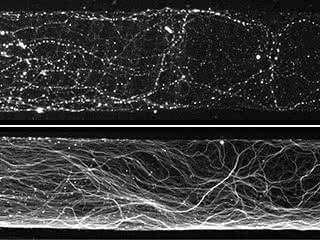Scientists question a popular theory about how the nervous system trims its branches
As tiny embryos in the womb, we start out with a lot more neuronal material than we actually need. During development, the body drastically prunes back the excess—cutting the branches from nerve cell bodies, known as axons, as well as entire neurons.
Scientists have long assumed that the decision whether to cull or keep an axon was coordinated by the axon itself, rather than by the cell body from which it extends. In recent years, tantalizing clues from several research groups have challenged that assumption. Now researchers at The Rockefeller University have proven that the cell body actively controls axon degeneration, and have uncovered many of the molecular details that allow this long-range communication.

Message from headquarters: Axons of normal neurons, shown on top, degenerate when deprived of NGF. However, the axons of neurons that lack the protein Puma remain intact (shown below), indicating that their degeneration is controlled by Puma and the cell body.
In a report published today online in Cell, they report that the instructions telling axons in developing embryos whether to live or die come from the cell body, not the axon. “This is a surprising finding,” notes senior author Marc Tessier-Lavigne, president of Rockefeller University and the Carson Family Professor and head of the Laboratory of Brain Development and Repair. “When the axon senses a ‘distress signal’—a lack of a growth factor called NGF—it doesn’t make the decision to degenerate by itself. It actually sends the information to the cell body, which is quite far away, and the cell body sends its decision back down the axon.”
Axons in distress
The survival of some axons depends on the presence of NGF in their local environment, a sign that there are plenty of nutrients around. “Because NGF is present at the tips of axons, far from the cell body, it has been hard for scientists to envision that the cell body played a central role in axon degeneration,” says co-first author David Simon, a postdoctoral fellow in the lab of Tessier-Lavigne. “And indeed, our study confirmed that all the cellular machinery that is needed to die is present in axon. However, the axon needs the message from the cell body to know when to degenerate.”
Tessier-Lavigne, Simon, co-first author Jason Pitts, and their colleagues followed a fairly straightforward procedure. They severed the connection between axons and the cell body in mouse neurons. When they removed NGF to mimic the distress signal that normally informs neurons that an axon should degenerate, they saw that only axons that remained connected to their cell bodies would do so. “When axons have been isolated from their cell body, the internal cell process that normally leads to their degeneration won’t turn on,” says Simon.
Looking closer, the researchers saw that when NGF levels fall, the cell body activates a gene that makes a protein known as Puma, which is associated with cell death and is present in the cell body. They suspect that once Puma gets activated, it triggers a message within the cell that ultimately instructs the axon to die.
A fail-safe mechanism
The idea that the cell body coordinates the degeneration signal in axons may be new to neuroscientists, but it does make biological sense, the researchers note. While axons only detect signals in their immediate environment, the cell body receives multiple cues about growth conditions from different directions. For instance, the Cell experiment used sensory neurons that convey pain in the skin’s surface, where NGF levels can fluctuate periodically. “Our findings show the axon won’t make the decision to die based on an immediate lack of NGF,” Simon says. By leaving the decision up to the cell body, the neuron has a “fail-safe” that prevents it from degenerating unnecessarily, the researchers propose.
The findings have potential implications for researchers studying certain conditions in which axons degenerate excessively, the authors note. In some neurodegenerative diseases, the affected neurons adopt some of the same pathways that drive axon pruning during normal embryonic development. The new findings suggest that some of these diseases may be caused by problems in signaling from the cell body, which keeps mistakenly green-lighting axon degeneration.
“If researchers could find a way to interfere with the expression or function of Puma, that could be very neuroprotective, and potentially protect neurons from degenerating,” says Simon.
This research was supported by the National Institutes of Health under grant number 1R01NS089786.
 Cell, online: February 18, 2016 Cell, online: February 18, 2016Axon Degeneration Gated by Retrograde Activation of Somatic Pro-apoptotic Signaling David J. Simon, Jason Pitts, Nicholas T. Hertz, Jing Yang, Yuya Yamagishi, Olav Olsen, Milica Tesic Mark, Henrik Molina, and Marc Tessier-Lavigne |


